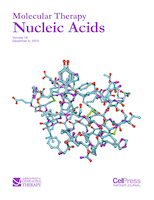
NUCLEOSIDES NUCLEOTIDES & NUCLEIC ACIDS
Scope & Guideline
Advancing Knowledge in Biochemistry and Genetics
Introduction
Aims and Scopes
- Genetic Polymorphisms and Disease Associations:
Research frequently explores the associations between genetic polymorphisms in nucleic acid-related genes and various diseases, including cancer, metabolic disorders, and infectious diseases. This area aims to elucidate how these genetic variations impact disease susceptibility and progression. - Nucleotide Metabolism and Therapeutics:
The journal publishes studies on the metabolism of nucleotides and their role in therapeutic contexts, particularly in cancer treatment and drug development. This includes investigations into nucleoside analogs and their mechanisms of action. - Molecular Biology Techniques and Innovations:
There is a strong emphasis on methodological advancements in molecular biology techniques, including the synthesis of nucleoside derivatives, oligonucleotide synthesis, and innovative analytical methods such as mass spectrometry and bioinformatics. - MicroRNAs and Long Non-Coding RNAs:
The exploration of microRNAs and long non-coding RNAs in gene regulation, cancer biology, and their potential as biomarkers or therapeutic targets is a key focus area. - Bioinformatics and Computational Biology:
The journal features research that employs bioinformatics tools and computational modeling to understand nucleic acid interactions, predict gene functions, and analyze large genomic datasets.
Trending and Emerging
- COVID-19 and Infectious Disease Research:
The impact of the COVID-19 pandemic has led to a surge in research related to genetic susceptibility, antiviral treatments, and the role of nucleotides in immune responses against infections. - Cancer Genomics and Precision Medicine:
There is an increasing emphasis on cancer genomics, particularly studies linking genetic variations and tumor biology to precision medicine approaches, which tailor treatments based on individual genetic profiles. - Functional Role of Non-Coding RNAs:
Research into the functional roles of non-coding RNAs, including microRNAs and long non-coding RNAs, is gaining prominence, with implications for cancer biology, gene regulation, and therapeutic applications. - Metabolomics and Nucleotide Profiling:
Emerging studies are focusing on metabolomic profiling of nucleotides and their metabolites in various biological contexts, providing insights into metabolic pathways and disease states. - Advanced Drug Delivery Systems:
Research on innovative drug delivery systems, particularly those utilizing nucleic acids for targeted therapy, is on the rise, reflecting the growing interest in nucleic acid-based therapeutics.
Declining or Waning
- Traditional Antiviral Agents:
Research focused on classical antiviral nucleoside analogs has decreased, possibly due to the rise of novel therapeutic approaches like RNA interference and CRISPR technology, which offer alternative strategies for viral infections. - Basic Nucleotide Biochemistry:
Studies that solely emphasize the biochemistry of nucleotides without clinical or therapeutic implications have waned. The journal's focus has increasingly shifted towards applications and translational research. - Plant-Based Nucleotide Sources:
Research into naturally occurring nucleosides and their extraction from plant sources has become less prominent, as synthetic and semi-synthetic approaches gain more attention for their efficiency and specificity.
Similar Journals

RNA
Exploring the Essence of Life Through RNARNA is a premier journal in the field of molecular biology, published by COLD SPRING HARBOR LAB PRESS, PUBLICATIONS DEPT. With an impressive impact factor reflected by its Q1 status in the Molecular Biology category, this journal has established itself as an essential resource for researchers and professionals dedicated to understanding the role of RNA in biological processes. Spanning over two decades of impactful research from 1995 to 2024, RNA covers a broad spectrum of topics, including RNA biology, gene regulation, and therapeutic innovations. Researchers can access its extensive array of original research articles, reviews, and commentary, making it a vital conduit for new discoveries and methodologies in the field. With its high ranking within Scopus at Rank #115/410 and a 72nd percentile ranking in the domain of Biochemistry, Genetics, and Molecular Biology, RNA continues to advance the understanding of RNA and its critical contributions to life sciences.

AIMS Molecular Science
Fostering Collaboration in Cutting-edge Molecular ResearchAIMS Molecular Science is a premier open-access journal published by the American Institute of Mathematical Sciences (AIMS), dedicated to the advancement and dissemination of high-quality research in the field of molecular science. Since its inception in 2014, this journal has established itself as a vital platform for researchers and professionals aiming to share their findings in molecular biology, chemistry, and interdisciplinary studies related to these domains. With an increasing focus on the accessibility of scientific knowledge, AIMS Molecular Science supports the open-access movement, ensuring that all published articles are freely available to the global research community. The journal emphasizes originality and significance in research, promoting innovative scientific methodologies and applications. By fostering collaboration and dialogue among scientists, AIMS Molecular Science plays a crucial role in advancing understanding and stimulating progress in molecular sciences.

ACTA BIOCHIMICA POLONICA
Advancing Insights in Biochemistry and Molecular BiologyACTA BIOCHIMICA POLONICA (ISSN: 0001-527X, E-ISSN: 1734-154X) is a distinguished journal published by the ACTA BIOCHIMICA POLONICA in Poland, with a rich history dating back to 1955. As a prominent platform for disseminating research, it currently holds a Category Quartile of Q3 in the fields of Biochemistry, Genetics, and Molecular Biology, reflecting its commitment to advancing knowledge in these critical areas. This journal is indexed in Scopus, ranking 124 out of 221, placing it in the 44th percentile among general biochemistry, genetics, and molecular biology journals. Although it does not operate under an open-access model, ACTA BIOCHIMICA POLONICA remains a vital resource for researchers, professionals, and students seeking to delve into the latest developments and discoveries in biochemistry and molecular biology. Its strategic focus on contemporary topics ensures that it plays an essential role in shaping future scientific inquiries and fostering collaboration across various disciplines.

Molecular Therapy Nucleic Acids
Empowering global collaboration in molecular therapy.Molecular Therapy Nucleic Acids is a premier open-access journal published by CELL PRESS, dedicated to advancing the field of molecular medicine through the innovative application of nucleic acid-based therapies. Since its inception in 2012, this journal has become an essential resource for researchers and professionals in drug discovery and molecular medicine, reflected in its status as a Q1 journal in both categories for 2023. With a notable impact factor and high rankings in Scopus, including #8 out of 157 in Drug Discovery and #16 out of 178 in Molecular Medicine, it serves to disseminate groundbreaking research and foster collaborations among scientists worldwide. The journal's comprehensive scope encompasses a wide variety of topics, including gene therapy, RNA interference, and CRISPR technology, ensuring that it remains at the forefront of scientific excellence. With open access availability, Molecular Therapy Nucleic Acids actively promotes the widespread dissemination of knowledge, making its crucial insights accessible to students, researchers, and industry professionals alike.

Non-coding RNA Research
Fostering Global Collaboration in RNA ResearchNon-coding RNA Research, published by KEAI PUBLISHING LTD, is a leading open-access journal dedicated to advancing the field of non-coding RNA, a critical component in the landscape of molecular biology and genetics. Established in 2016, this journal aims to provide a platform for the dissemination of high-quality research focusing on the roles, mechanisms, and therapeutic potentials of non-coding RNAs in various biological processes and diseases. With impressive Scopus rankings placing it in the top quartile for both Biochemistry and Medical Biochemistry, as well as notable standings in Genetics and Molecular Biology, Non-coding RNA Research continues to attract contributions from globally recognized experts. The journal's commitment to open access ensures broad visibility and engagement with cutting-edge discoveries, thereby fostering an inclusive scientific dialogue that enhances understanding and innovation in this rapidly evolving field. For researchers and scholars, the opportunity to publish in a Q1 ranked journal not only validates their work but also enhances its impact, making Non-coding RNA Research an indispensable resource for anyone interested in the intricate workings of non-coding RNA.

CELLULAR & MOLECULAR BIOLOGY LETTERS
Transforming Knowledge in Biochemistry and Cell BiologyCELLULAR & MOLECULAR BIOLOGY LETTERS, published by BMC, is a premier open-access journal dedicated to disseminating high-quality research in the fields of Biochemistry, Cell Biology, and Molecular Biology. Established in 1996, the journal has emerged as a leader in its domain, boasting an impressive Q1 ranking across three critical categories as of 2023, reflecting its significant impact within the scientific community. With an ISSN of 1425-8153 and an E-ISSN of 1689-1392, it offers accessible research findings to a global audience, having been open access since 2013. Situated in the United Kingdom, at CAMPUS, 4 CRINAN ST, LONDON N1 9XW, the journal continues to serve as a vital resource for researchers, professionals, and students, contributing to advancements in the understanding of cellular and molecular processes. By providing a platform for original research, reviews, and short communications, CELLULAR & MOLECULAR BIOLOGY LETTERS plays a crucial role in fostering dialogue and collaboration within the scientific community.

NUCLEIC ACIDS RESEARCH
Catalyzing Innovations in Genetic ResearchNUCLEIC ACIDS RESEARCH, published by Oxford University Press, is a premier peer-reviewed journal in the field of genetics, holding a prestigious Q1 ranking in this domain as of 2023. Since its inception in 1974 and with a converged publication horizon extending to 2024, this journal has established itself as a vital resource for researchers and professionals interested in the molecular aspects of nucleic acids, encompassing DNA and RNA studies as well as their implications in biochemistry and molecular biology. With an impressive Scopus rank of #6 out of 347 in Genetics, this journal is positioned in the 98th percentile among its peers, highlighting its significant impact and relevance in the scientific community. As an open access journal since 2005, NUCLEIC ACIDS RESEARCH ensures wide dissemination of knowledge, promoting collaborative advancements in genetic research. For those looking to stay at the forefront of nucleic acid research, this journal remains an essential publication for accessing cutting-edge findings and innovative methodologies in the field.

INTERNATIONAL JOURNAL OF MOLECULAR MEDICINE
Elevating the standards of molecular research excellence.International Journal of Molecular Medicine is a prestigious publication dedicated to advancing the field of molecular medicine through innovative research and scholarly dialogue. Published by Spandidos Publications Ltd in Greece, this journal has successfully provided a platform for academics and professionals alike since its inception in 1998. With an impressive 2023 Q1 ranking in Medicine (Miscellaneous) and a Q2 ranking in Genetics, the journal maintains a vital role in disseminating high-quality research, underscored by its strong performance in the Scopus rankings, particularly in the realm of genetics where it ranks 28 out of 347. Researchers will benefit from its comprehensive scope, which encompasses a wide range of topics within molecular biology, genetics, and their clinical applications. Although the journal does not operate under an open access model, it remains influential, providing critical insights that contribute significantly to the understanding and development of molecular therapeutic strategies and innovations.

Cancer Cell International
Pioneering Insights in Cancer Cell BiologyCancer Cell International, published by BMC, is a transformative open-access journal established in 2001, dedicated to advancing the field of oncology and cancer research. With its ISSN number not specified and an E-ISSN of 1475-2867, the journal proudly operates from the United Kingdom, located at CAMPUS, 4 Crinan St, London N1 9XW, England. Renowned for its rigorous peer-review process, Cancer Cell International has made significant strides, securing a Q2 ranking in Cancer Research and Q1 rankings in both Genetics and Oncology as of 2023. It ranks impressively in Scopus, featuring in the top quintile of Genetics (#37/347) and Oncology (#52/404), indicating its importance within the scientific community. The journal's broad scope caters to a diverse array of topics within cancer biology, making it an invaluable resource for researchers, professionals, and students seeking to stay at the forefront of cancer science. With a commitment to disseminating high-quality research, Cancer Cell International invites scholars to explore innovative findings and contribute to the collective effort of combating cancer.

FUNCTIONAL & INTEGRATIVE GENOMICS
Elevating Genomic Science for a Healthier TomorrowFUNCTIONAL & INTEGRATIVE GENOMICS, published by Springer Heidelberg, is a leading journal in the fields of genetics and molecular biology. Established in 2000, it serves as a pivotal platform for advancing our understanding of genomic functionality and integration, making significant contributions to both basic and applied research in genetics. With a robust impact factor and a ranking in the Q3 quartile for Genetics and Q2 for Medicine (Miscellaneous), the journal aims to publish innovative research that explores the relationships between genomic data and biological functions, appealing to a diverse audience of researchers and professionals. Although it operates under a subscription model, the journal's extensive archives remain a valuable resource for academics seeking to stay abreast of the latest findings and methodologies in genomics. As the field evolves, FUNCTIONAL & INTEGRATIVE GENOMICS remains committed to fostering scholarly dialogue and the dissemination of groundbreaking studies that influence future research trajectories.